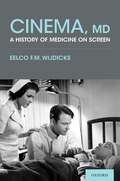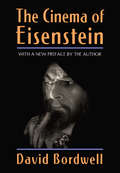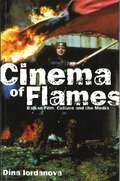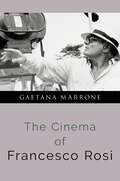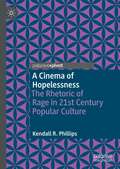- Table View
- List View
Cinema, Law, and the State in Asia
by C. Creekmur M. SidelThis book explores the intersections of film, justice, and the state in comparative perspective across a range of major Asian countries, including India, China, Japan, Korea, the Philippines, and Vietnam. The contributing authors cross the conventional border between the analysis of on-screen and off-screen intersections of law and cinema.
Cinema, MD: A History of Medicine On Screen
by Eelco F.M. WijdicksCinema, MD follows the intersection of medicine and film and how filmmakers wrote a history of medicine over time. The narrative follows several main story lines: How did the portrayal of physicians, nurses, and medical institutions change over the years? What interested filmmakers, and which topics had priority? What does film's obsession with experiments and monstrosities reveal about medical ethics and malpractice? How could the public's perception of the medical profession change when watching these films on diseases and treatments, including palliative care and medical ethics? Are screenwriters, actors, and film directors channeling a popular view of medicine? Cinema, MD analyzes not only changing practices, changing morals, and changing expectations but also medical stereotypes, medical activism, and violations of patients' integrity and autonomy. Examining over 400 films with medical themes over a century of cinema, this book establishes the cultural, medical, and historical importance of the art form. Film allows us to see our humanity, our frailty, and our dependence when illness strikes. Cinema, MD provides uniquely new and fascinating insight into both film criticism and the history of medicine and has a resonance to the medical world we live in today.
Cinema, MD: A History of Medicine On Screen
by Eelco F.M. WijdicksCinema, MD follows the intersection of medicine and film and how filmmakers wrote a history of medicine over time. The narrative follows several main story lines: How did the portrayal of physicians, nurses, and medical institutions change over the years? What interested filmmakers, and which topics had priority? What does film's obsession with experiments and monstrosities reveal about medical ethics and malpractice? How could the public's perception of the medical profession change when watching these films on diseases and treatments, including palliative care and medical ethics? Are screenwriters, actors, and film directors channeling a popular view of medicine? Cinema, MD analyzes not only changing practices, changing morals, and changing expectations but also medical stereotypes, medical activism, and violations of patients' integrity and autonomy. Examining over 400 films with medical themes over a century of cinema, this book establishes the cultural, medical, and historical importance of the art form. Film allows us to see our humanity, our frailty, and our dependence when illness strikes. Cinema, MD provides uniquely new and fascinating insight into both film criticism and the history of medicine and has a resonance to the medical world we live in today.
Cinema Memories: A People's History of Cinema-going in 1960s Britain
by Melvyn Stokes Emma Pett Matthew JonesCinema Memories brings together and analyses the memories of almost a thousand people of going to the cinema in Britain during the 1960s. It offers a fresh perspective on the social, cultural and film history of what has come to be seen as an iconic decade, with the release of films such as A Taste of Honey, The Sound of Music, Darling, Blow-Up, Alfie, The Graduate, and Bonnie and Clyde. Drawing on first-hand accounts, authors Melvyn Stokes, Matthew Jones and Emma Pett explore how cinema-goers constructed meanings from the films they watched - through a complex process of negotiation between the films concerned, their own social and cultural identities, and their awareness of changes in British society. Their analysis helps the reader see what light the cultural memory of 1960s cinema-going sheds on how the Sixties in Britain is remembered and interpreted. Positioning their study within debates about memory, 1960s cinema, and the seemingly transformative nature of this decade of British history, the authors reflect on the methodologies deployed, the use of memories as historical sources, and the various ways in which cinema and cinema-going came to mean something to their audiences.
Cinema Memories: A People's History of Cinema-going in 1960s Britain
by Melvyn Stokes Emma Pett Matthew JonesCinema Memories brings together and analyses the memories of almost a thousand people of going to the cinema in Britain during the 1960s. It offers a fresh perspective on the social, cultural and film history of what has come to be seen as an iconic decade, with the release of films such as A Taste of Honey, The Sound of Music, Darling, Blow-Up, Alfie, The Graduate, and Bonnie and Clyde. Drawing on first-hand accounts, authors Melvyn Stokes, Matthew Jones and Emma Pett explore how cinema-goers constructed meanings from the films they watched - through a complex process of negotiation between the films concerned, their own social and cultural identities, and their awareness of changes in British society. Their analysis helps the reader see what light the cultural memory of 1960s cinema-going sheds on how the Sixties in Britain is remembered and interpreted. Positioning their study within debates about memory, 1960s cinema, and the seemingly transformative nature of this decade of British history, the authors reflect on the methodologies deployed, the use of memories as historical sources, and the various ways in which cinema and cinema-going came to mean something to their audiences.
Cinema-monde: Decentred Perspectives on Global Filmmaking in French
by Michael Gott Thibaut SchiltThe story of the Crown’s challenge to Scottish foreshore ownership
Cinema-monde: Decentred Perspectives on Global Filmmaking in French
by Michael Gott Thibaut SchiltA history of independent cinema in the US from an industrial perspective
The Cinema of Cecilia Bartolomé: Feminism and Francoism (Spanish and Latin-American Filmmakers)
by Sally FaulknerWere it not for authoritarian state censorship, Cecilia Bartolomé’s name would figure alongside those of her contemporaries Agnès Varda and Claire Denis as a pioneering feminist filmmaker of the twentieth century. With this bold claim, this book seeks both to write the history of Bartolomé’s extant filmography, and speculate about censored and un-filmed work, thereby fashioning a new way of writing a feminist creative life in film.The first volume on this director to be written in English, The Cinema of Cecilia Bartolomé is also the first volume on the director published in any language for over twenty years. By focusing on Spanish-language cinema of the 1960s-90s, the period when feminism, like democracy, was re-born and seemingly consolidated in Spain, the study brings historical depth and transnational reach to current debates in the wake of #MeToo.
The Cinema of Cecilia Bartolomé: Feminism and Francoism (Spanish and Latin-American Filmmakers)
by Sally FaulknerWere it not for authoritarian state censorship, Cecilia Bartolomé’s name would figure alongside those of her contemporaries Agnès Varda and Claire Denis as a pioneering feminist filmmaker of the twentieth century. With this bold claim, this book seeks both to write the history of Bartolomé’s extant filmography, and speculate about censored and un-filmed work, thereby fashioning a new way of writing a feminist creative life in film.The first volume on this director to be written in English, The Cinema of Cecilia Bartolomé is also the first volume on the director published in any language for over twenty years. By focusing on Spanish-language cinema of the 1960s-90s, the period when feminism, like democracy, was re-born and seemingly consolidated in Spain, the study brings historical depth and transnational reach to current debates in the wake of #MeToo.
Cinema of Choice: Optional Thinking and Narrative Movies
by Nitzan Ben ShaulStandard Hollywood narrative movies prescribe linear narratives that cue the viewer to expect predictable outcomes and adopt a closed state of mind. There are, however, a small number of movies that, through the presentation of alternate narrative paths, open the mind to thoughts of choice and possibility. Through the study of several key movies for which this concept is central, such as Sliding Doors, Run Lola Run, Inglourious Basterds, and Rashomon, Nitzan Ben Shaul examines the causes and implications of optional thinking and how these movies allow for more open and creative possibilities. This book examines the methods by which standard narrative movies close down thinking processes and deliver easy pleasures to the viewer whilst demonstrating that this is not the only possibility and that optional thinking can be both stimulating and rewarding.
Cinema of Collaboration: DEFA Coproductions and International Exchange in Cold War Europe (Film Europa #21)
by Mariana IvanovaFrom their very inception, European cinemas undertook collaborative ventures in an attempt to cultivate a transnational “Film-Europe.” In the postwar era, it was DEFA, the state cinema of East Germany, that emerged as a key site for cooperative practices. Despite the significant challenges that the Cold War created for collaboration, DEFA sought international prestige through various initiatives. These ranged from film exchange in occupied Germany to partnerships with Western producers, and from coproductions with Eastern European studios to strategies for film co-authorship. Uniquely positioned between East and West, DEFA proved a crucial mediator among European cinemas during a period of profound political division.
The Cinema of Discomfort: Disquieting, Awkward and Uncomfortable Experiences in Contemporary Art and Indie Film
by Geoff KingHow do we understand types of cinema that offer experiences of discomfort, awkwardness or disquieting uncertainty? This book examines a number of examples of such work at the heart of contemporary art and indie film. While the commercial mainstream tends to offer comforting viewing experiences – or moments of discomfort that exist largely to be overcome – The Cinema of Discomfort analyses films in which discomfort is offered in a sustained manner. Cinema of this kind confronts us with material such as distinctly uncomfortable sexual encounters. It invites us into uncertain relationships with awkward and sometimes unlikable characters. It presents us with challenging behaviour or what are presented as uncomfortable realities. It often refuses information on which to base judgments. More discomfortingly, cinema of this kind tends to provoke uncertainty at the level of what emotional responses we are encouraged to have towards difficult, sometimes controversial, characters or events. The Cinema of Discomfort examines a number of case-studies, including Palindromes by Todd Solondz (US) and Dogtooth from Yorgos Lanthimos (Greece), along with other examples from Austria, Sweden, the UK, the US and Germany. Offering close textual analysis of the manner in which discomfort is generated, it also asks how we should understand the appeal of such work to certain viewers and how the existence of films of this kind can be explained, as products of both their socio-cultural context and the more particular institutional realms of art and indie film.
The Cinema of Discomfort: Disquieting, Awkward and Uncomfortable Experiences in Contemporary Art and Indie Film
by Geoff KingHow do we understand types of cinema that offer experiences of discomfort, awkwardness or disquieting uncertainty? This book examines a number of examples of such work at the heart of contemporary art and indie film. While the commercial mainstream tends to offer comforting viewing experiences – or moments of discomfort that exist largely to be overcome – The Cinema of Discomfort analyses films in which discomfort is offered in a sustained manner. Cinema of this kind confronts us with material such as distinctly uncomfortable sexual encounters. It invites us into uncertain relationships with awkward and sometimes unlikable characters. It presents us with challenging behaviour or what are presented as uncomfortable realities. It often refuses information on which to base judgments. More discomfortingly, cinema of this kind tends to provoke uncertainty at the level of what emotional responses we are encouraged to have towards difficult, sometimes controversial, characters or events. The Cinema of Discomfort examines a number of case-studies, including Palindromes by Todd Solondz (US) and Dogtooth from Yorgos Lanthimos (Greece), along with other examples from Austria, Sweden, the UK, the US and Germany. Offering close textual analysis of the manner in which discomfort is generated, it also asks how we should understand the appeal of such work to certain viewers and how the existence of films of this kind can be explained, as products of both their socio-cultural context and the more particular institutional realms of art and indie film.
The Cinema of Eisenstein
by David BordwellThe Cinema of Eisenstein is David Bordwell's comprehensive analysis of the films of Sergei Eisenstein, arguably the key figure in the entire history of film. The director of such classics as Potemkin, Ivan the Terrible, October, Strike, and Alexander Nevsky, Eisenstein theorized montage, presented Soviet realism to the world, and mastered the concept of film epic. Comprehensive, authoritative, and illustrated throughout, this classic work deserves to be on the shelf of every serious student of cinema.
The Cinema of Eric Rohmer: Irony, Imagination, and the Social World
by Jacob LeighSince the death of the French film director Eric Rohmer in 2010, interest in his work has reignited. Known as the last of the established directors in the French New Wave, Rohmer took complete control over all his films, acting as his own producer throughout his career, and writing the scripts. He also made his mark by taking the lead in casting and location scouting - as French seaside resorts with beautiful young people are some of the elements present in most of his films. Combining history and criticism, Jacob Leigh pens the first chronological survey of this understudied filmmaker in order to give readers clear insights into how Rohmer's films came about and what he intended them to be. The book provides in-depth analysis of the themes and ideas of Rohmer's twenty-three feature films, and illustrates the complexity of their cinematic style. Leigh's study is the perfect introduction to the work of this great filmmaker, for both students and the general reader.
The Cinema of Eric Rohmer: Irony, Imagination, and the Social World
by Jacob LeighSince the death of the French film director Eric Rohmer in 2010, interest in his work has reignited. Known as the last of the established directors in the French New Wave, Rohmer took complete control over all his films, acting as his own producer throughout his career, and writing the scripts. He also made his mark by taking the lead in casting and location scouting - as French seaside resorts with beautiful young people are some of the elements present in most of his films. Combining history and criticism, Jacob Leigh pens the first chronological survey of this understudied filmmaker in order to give readers clear insights into how Rohmer's films came about and what he intended them to be. The book provides in-depth analysis of the themes and ideas of Rohmer's twenty-three feature films, and illustrates the complexity of their cinematic style. Leigh's study is the perfect introduction to the work of this great filmmaker, for both students and the general reader.
The Cinema of Federico Fellini
by Peter BondanellaThis major artistic biography of Federico Fellini shows how his exuberant imagination has been shaped by popular culture, literature, and his encounter with the ideas of C. G. Jung, especially Jungian dream interpretation. Covering Fellini's entire career, the book links his mature accomplishments to his first employment as a cartoonist, gagman, and sketch-artist during the Fascist era and his development as a leading neo-realist scriptwriter. Peter Bondanella thoroughly explores key Fellinian themes to reveal the director's growth not only as an artistic master of the visual image but also as an astute interpreter of culture and politics. Throughout the book Bondanella draws on a new archive of several dozen manuscripts, obtained from Fellini and his scriptwriters. These previously unexamined documents allow a comprehensive treatment of Fellini's important part in the rise of Italian neorealism and the even more decisive role that he played in the evolution of Italian cinema beyond neorealism in the 1950s. By probing Fellini's recurring themes, Bondanella reinterprets the visual qualities of the director's body of work--and also discloses in the films a critical and intellectual vitality often hidden by Fellini's reputation as a storyteller and entertainer. After two chapters on Fellini's precinematic career, the book covers all the films to date in analytical chapters arranged by topic: Fellini and his growth beyond his neorealist apprenticeship, dreams and metacinema, literature and cinema, Fellini and politics, Fellini and the image of women, and La voce della luna and the cinema of poetry.
Cinema of Flames: Balkan Film, Culture and the Media
by Dina IordanovaFirst study of cinema, media and the Balkan wars; Wide-ranging view of politics and culture of the region; The break-up of Yugoslavia triggered a truly international film-making project. Underground, Ulysses' Gaze, Before the Rain, Pretty Village, Pretty Flame and Welcome to Sarajevo were amongst a host of films created as the conflicts in the region unravelled. These conflicts restored the Balkans as a centrepiece of Western imagery and the media (especially cinema) assumed a leading but ambiguous role in defining it for global consumption through a narrow range of selectively defined images. Simultaneously, a lot of the high-quality cinematic and television work made in the region (much of it discussed in this book) remains relatively unknown. Cinema of Flames attempts to go deeper than the imagery and address some of the general concerns of the cross-cultural representation and self-representation of the Balkans: narrative strategies within the context of Balkan exclusion from the European cultural sphere, the cosmopolitan image of Sarejevo, diaspora, and the representations of villains, victims, women, and ethnic minorities, all considered in the general context of Balkan cinema. 'encyclopaedic in scope and brilliance, making excellent use of the scholarly literature whilst interweaving analysis of films and other mass media. The book will be a superb addition to the literatures on Bosnia and Yugoslavia. It will also serve as a standard reference on Balkans film.' Robert Hayden (University of Pittsburgh)
Cinema of Flames: Balkan Film, Culture and the Media
by Dina IordanovaFirst study of cinema, media and the Balkan wars; Wide-ranging view of politics and culture of the region; The break-up of Yugoslavia triggered a truly international film-making project. Underground, Ulysses' Gaze, Before the Rain, Pretty Village, Pretty Flame and Welcome to Sarajevo were amongst a host of films created as the conflicts in the region unravelled. These conflicts restored the Balkans as a centrepiece of Western imagery and the media (especially cinema) assumed a leading but ambiguous role in defining it for global consumption through a narrow range of selectively defined images. Simultaneously, a lot of the high-quality cinematic and television work made in the region (much of it discussed in this book) remains relatively unknown. Cinema of Flames attempts to go deeper than the imagery and address some of the general concerns of the cross-cultural representation and self-representation of the Balkans: narrative strategies within the context of Balkan exclusion from the European cultural sphere, the cosmopolitan image of Sarejevo, diaspora, and the representations of villains, victims, women, and ethnic minorities, all considered in the general context of Balkan cinema. 'encyclopaedic in scope and brilliance, making excellent use of the scholarly literature whilst interweaving analysis of films and other mass media. The book will be a superb addition to the literatures on Bosnia and Yugoslavia. It will also serve as a standard reference on Balkans film.' Robert Hayden (University of Pittsburgh)
The Cinema of Francesco Rosi
by Gaetana MarroneFrancesco Rosi is one of the great realist artists of post-war Italian, indeed post-war world cinema. In this book, author Gaetana Marrone explores the rich visual language in which the Neapolitan filmmaker expresses the cultural icons that constitute his style and images. Over the years, Rosi has offered us films that trace an intricate path between the real and the fictive, the factual and the imagined. His films show an extraordinarily consistent formal balance while representing historical events as social emblems that examine, shape, and reflect the national self. They rely on a labyrinthine narrative structure, in which the sense of an enigma replaces the unidirectional path leading ineluctably to a designated end and solution. Rosi's logical investigations are conducted by an omniscient eye and translated into a cinematic approach that embraces the details of material reality with the panoramic perspective of a dispassionate observer. This book offers intertextual analyses within such fields as history, politics, literature, and photography, along with production information gleaned from Rosi's personal archives and interviews. It examines Rosi's creative use of film as document, and as spectacle). It is also a study of the specific cinematic techniques that characterize Rosi's work and that visually, compositionally, express his vision of history and the elusive "truth" of past and present social and political realities.
The Cinema of Hal Hartley
by Sebastian ManleyOne of the most significant contributors to the American independent cinema that developed over the late 1980s and 1990s, Hal Hartley has throughout his career created films that defy convention and capture the stranger realities of modern American life. The Cinema of Hal Hartley looks at all of Hartley's film releases - from cult classics such as The Unbelievable Truth and Trust to oddball genre experiments such as No Such Thing and Fay Grim to short films such as Opera No. 1 and Accomplice - and makes a case for seeing Hartley as an important and successful American auteur, despite the director's decline in status in the later stages of his career. Employing both industrial and close textual analysis, the book considers aspects of Hartley's work such as genre, gender and form, as well as dimensions far less frequently discussed in studies of indie directors, such as place and cultural identity, offering a broad and innovative study of a productive filmmaker who continues to show a singular disregard for the expectations of both the mainstream and the indie cinema industries.
The Cinema of Hal Hartley
by Sebastian ManleyOne of the most significant contributors to the American independent cinema that developed over the late 1980s and 1990s, Hal Hartley has throughout his career created films that defy convention and capture the stranger realities of modern American life. The Cinema of Hal Hartley looks at all of Hartley's film releases - from cult classics such as The Unbelievable Truth and Trust to oddball genre experiments such as No Such Thing and Fay Grim to short films such as Opera No. 1 and Accomplice - and makes a case for seeing Hartley as an important and successful American auteur, despite the director's decline in status in the later stages of his career. Employing both industrial and close textual analysis, the book considers aspects of Hartley's work such as genre, gender and form, as well as dimensions far less frequently discussed in studies of indie directors, such as place and cultural identity, offering a broad and innovative study of a productive filmmaker who continues to show a singular disregard for the expectations of both the mainstream and the indie cinema industries.
A Cinema of Hopelessness: The Rhetoric of Rage in 21st Century Popular Culture (Rhetoric, Politics and Society)
by Kendall R. PhillipsThis book explores the circulation of anger and hostility in contemporary American culture with particular attention to the fantasy of refusal, a dream of rejecting all the structures of the contemporary political and economic system. Framing the question of public sentiment through the lens of rhetorical studies, this book traces the circulation of symbols that craft public feelings in contemporary popular cinema. Analyzing popular twenty-first century films as invitations to a particular way of feeling, the book delves into the way popular sentiments are circulated and intensified. The book examines dystopian films (The Purge, The Cabin in the Woods), science fiction (Snowpiercer), and superhero narratives (the Marvel Cinematic Universe and Joker). Across these varied films, an affective economy that emphasizes grief, betrayal, refusal, and an underlying rage at the seeming hopelessness of contemporary culture is uncovered. These examinations are framed in terms of ongoing political protests ranging from Occupy Wall Street, the Tea Party, Black Lives Matter, and the 6th January 2021 invasion of the US Capitol Building.
Cinema of Interruptions: Action Genres in Contemporary Indian Cinema
by Lalitha GopalanA framework for understanding the distinctiveness of Indian cinema as a national cinema within a global context dominated by Hollywood is proposed by this book. With its sudden explosions into song-and-dance sequences, half-time intermissions and heavy traces of censorship, Indian cinema can be identified as a 'Cinema of Interruptions'. To the uninitiated viewer, brought up on the seamless linear plotting of Hollywood narrative, this unfamiliar tendency towards digression may appear random and superfluous, yet this book argues that such devices assist in the construction of a distinct visual and narrative time-space. In the hands of imaginative directors, the conventions of Indian cinema become opportunities for narrative play and personal expression in such films as 'Sholay' (1975), 'Nayakan' (1987), 'Parinda' (1989), 'Hathyar' (1981) and 'Hey Ram!' (1999). 'Cinema of Interruptions' places commercial Indian film within a global system of popular cinemas, but also points out its engagement with the dominant genre principles implemented by Western film. By focusing on the action-genre work of leading contemporary directors J.P. Dutta, Mani Ratnam, and Vidhu Vinod Chopra, brazen national style is shown to interact with international genre films to produce a hybrid form that reworks the gangster film, the western and the avenging woman genre. Central to this study is the relationship Indian cinema shares with its audience, and an understanding of the pleasures it offers the cinephile. In articulating this bond the book presents not only a fresh framework for understanding popular Indian cinema but also a contribution to film genre studies.

